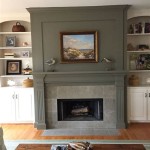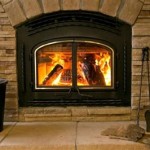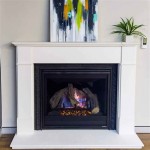Updating a Fireplace Mantel: A Comprehensive Guide
The fireplace mantel serves as a focal point in many living spaces, drawing the eye and contributing significantly to the overall aesthetic. An outdated or poorly maintained mantel can detract from the room's appeal, while a refreshed or renovated mantel can revitalize the entire space, even without extensive renovations to the entire room. Updating a fireplace mantel involves a range of considerations, from assessing the existing structure and materials to selecting appropriate design elements and implementing the chosen updates. This article will provide a comprehensive overview of the key aspects involved in updating a fireplace mantel, encompassing planning, preparation, and execution.
Assessing the Existing Mantel
Before embarking on any updates, a thorough assessment of the existing mantel is crucial. This assessment should encompass several key areas, including structural integrity, material condition, style appropriateness, and potential limitations. Understanding the existing mantel's attributes and deficiencies will inform the subsequent decisions regarding updates.
The structural integrity of the mantel must be evaluated. Check for signs of damage such as cracks, warping, or loose joints, particularly if the mantel is made of wood. If such damages are found, they must be addressed before any cosmetic changes are made. For stone or brick mantels, inspect for crumbling mortar or loose stones. Safety should always be the paramount concern. If the mantel is severely compromised, professional consultation may be necessary to determine the most appropriate course of action, which may involve repair or complete replacement.
The material condition is another important aspect. Painted mantels may exhibit chipping, peeling, or fading. Wooden mantels might have scratches, dents, or water stains. Stone or brick mantels can show signs of discoloration or staining. Understanding the type and extent of the material damage will influence the choice of cleaning, repair, or refinishing techniques. For instance, a peeling painted mantel will require stripping and repainting, whereas a water-stained wooden mantel might necessitate sanding and restaining.
The style appropriateness refers to how well the existing mantel complements the overall style of the room. A traditional mantel might look out of place in a modern, minimalist space, and vice versa. Evaluating the mantel's style in relation to the room's decor will help determine whether a simple refinishing or a more significant stylistic alteration is needed. Consider the architectural style of the house and how the mantel fits into the broader design scheme. If the style is fundamentally incongruent, more extensive modifications or a complete replacement may be necessary to achieve a cohesive look.
Finally, potential limitations of the existing mantel need to be identified. Consider the size and shape of the mantel in relation to the fireplace and the surrounding wall space. Are there any physical constraints that might limit the scope of potential updates? For example, a small mantel may not be able to accommodate larger decorative items, or a mantel that is too close to the firebox may pose a safety hazard if flammable materials are used. Understanding these limitations will help guide the design process and ensure that the updates are both aesthetically pleasing and functionally sound.
Planning and Design Considerations
Once the existing mantel has been thoroughly assessed, the next step is to develop a detailed plan for the updates. This plan should include a clear articulation of the desired aesthetic, a budget, a timeline, and a detailed list of materials and tools required. Careful planning is essential for a successful mantel update.
Articulating the desired aesthetic is crucial. What is the overall look you want to achieve? Are you aiming for a modern, rustic, traditional, or eclectic style? Gather inspiration from magazines, websites, and home decor stores to identify specific design elements that appeal to you. Consider the color palette, materials, and decorative accessories that will be used to create the desired ambiance. A mood board can be helpful in visualizing the final result and ensuring that all design elements are cohesive. The desired aesthetic should be consistent with the room's existing decor and your personal taste.
Establishing a budget is essential for managing costs and avoiding overspending. Determine how much you are willing to spend on the mantel update, taking into account the cost of materials, tools, and professional labor if needed. Research the prices of different materials and compare quotes from contractors to get an accurate estimate of the total project cost. Be realistic about your budget and prioritize the most important aspects of the update. It is often wise to allocate a contingency fund for unexpected expenses that may arise during the project.
Creating a timeline will help keep the project on track and ensure that it is completed within a reasonable timeframe. Break down the project into smaller, manageable tasks and estimate the time required for each task. Consider any potential delays, such as material availability or weather conditions, and factor them into the timeline. A well-defined timeline will help you stay organized and motivated throughout the project. It also allows you to coordinate with any contractors or other professionals involved in the update.
Creating a detailed list of materials and tools required is a critical step in the planning process. This list should include everything needed to complete the project, from basic supplies like sandpaper, paint, and brushes to specialized tools like saws, drills, and measuring tapes. Consider the specific tasks involved in the update and ensure that you have the appropriate tools for each task. Purchasing high-quality materials and tools will ensure a better finished product and longer-lasting results. Having all the necessary materials and tools on hand before starting the project will help avoid delays and frustration.
Implementing the Mantel Update
With a well-defined plan in place, the implementation phase can begin. This phase involves preparing the area, executing the chosen updates, and adding finishing touches. Careful execution is essential for achieving a professional and aesthetically pleasing result.
Properly preparing the area is critical for a successful outcome. This involves protecting the surrounding surfaces from dust, paint, or other materials. Cover the floor with drop cloths and use painter's tape to mask off any areas that you do not want to be affected by the update. Remove any decorative items from the mantel and surrounding area. Clean the mantel thoroughly to remove any dirt, dust, or grease. Preparing the area properly will minimize cleanup and prevent damage to other surfaces.
Executing the chosen updates involves implementing the specific changes that you have planned. This may involve stripping and repainting a painted mantel, sanding and restaining a wooden mantel, or replacing the entire mantel with a new one. Follow the manufacturer's instructions for any products you are using and take precautions to ensure your safety. Work carefully and methodically, paying attention to detail. If you are not comfortable performing certain tasks, consider hiring a professional to do them for you. For example, intricate carpentry work or stone masonry may be best left to experienced professionals.
Adding finishing touches elevates the overall appearance of the updated mantel. This may involve installing new hardware, such as decorative brackets or a new mantel shelf. Consider adding decorative accessories, such as vases, candles, or picture frames, to enhance the mantel's visual appeal. Ensure that the decorative items complement the style of the mantel and the room's decor. Pay attention to the arrangement of the decorative items, creating a balanced and visually pleasing display. The finishing touches are what truly bring the entire update together and create a polished and cohesive look.
Following these steps will lead to a refreshed fireplace mantel that enhances the aesthetic appeal of the living space. Careful planning, meticulous execution, and attention to detail are essential for achieving a successful and satisfying result. Remember to prioritize safety throughout the project and consult with professionals when needed.

Mantel Makeover With Paint

How To Update The Look Of Your Fireplace

30 Fireplace Remodel Ideas For Any Budget

Fireplace Makeover Update Rustic Mantel Beam The Lettered Cottage

How To Update A Fireplace On Budget Home Matters Ahs

Diy Rustic Fireplace Mantel The Cure For A Boring

How To Paint Your Mantel And Get Clean Lines Postcards From The Ridge

Painted Fireplace Mantels Add Zz

How To Update A Fireplace Hearth And Mantel Pasha Is Home

Diy Fireplace Makeover Part Two Kilz Priming And Painting The Perfect Finish Blog By
Related Posts








